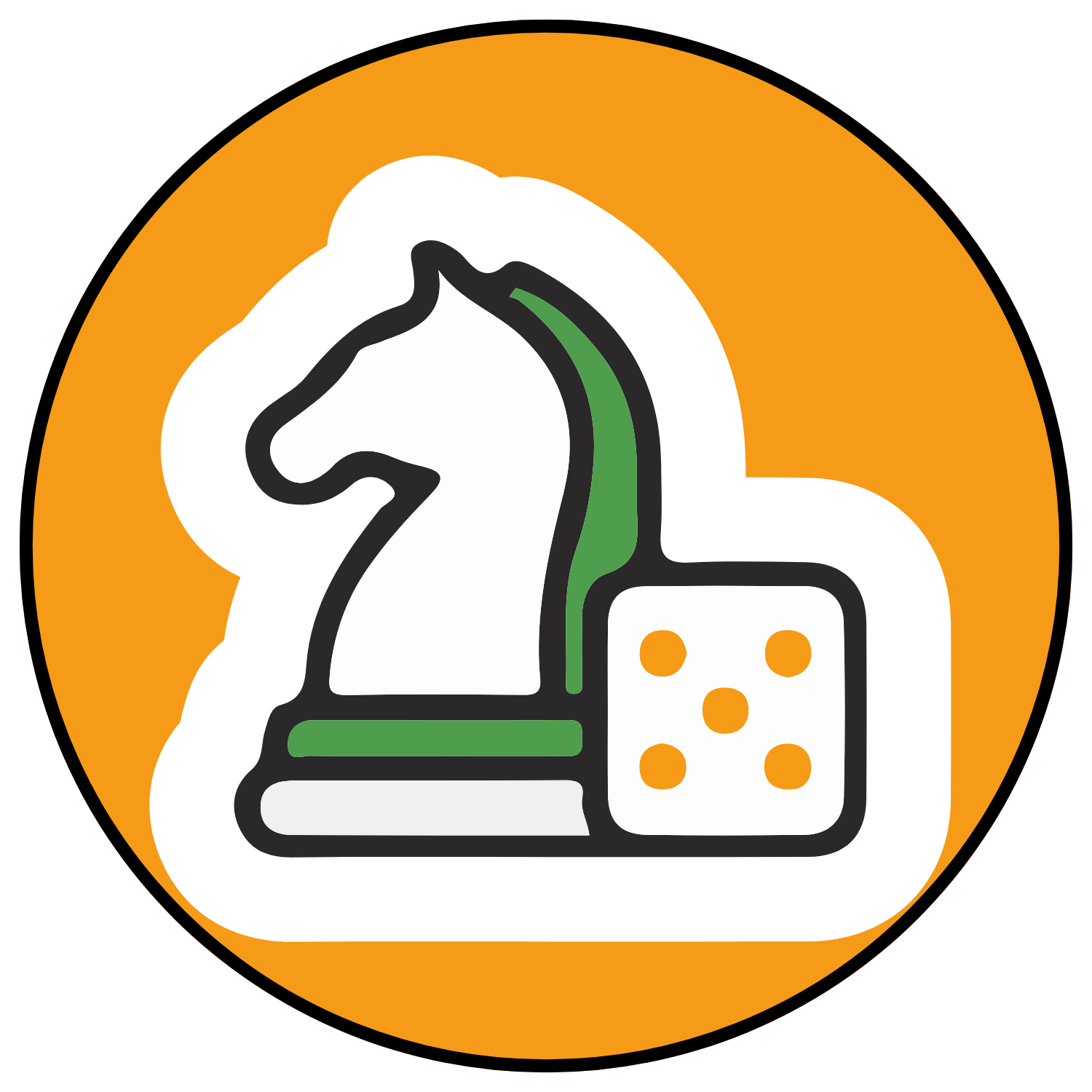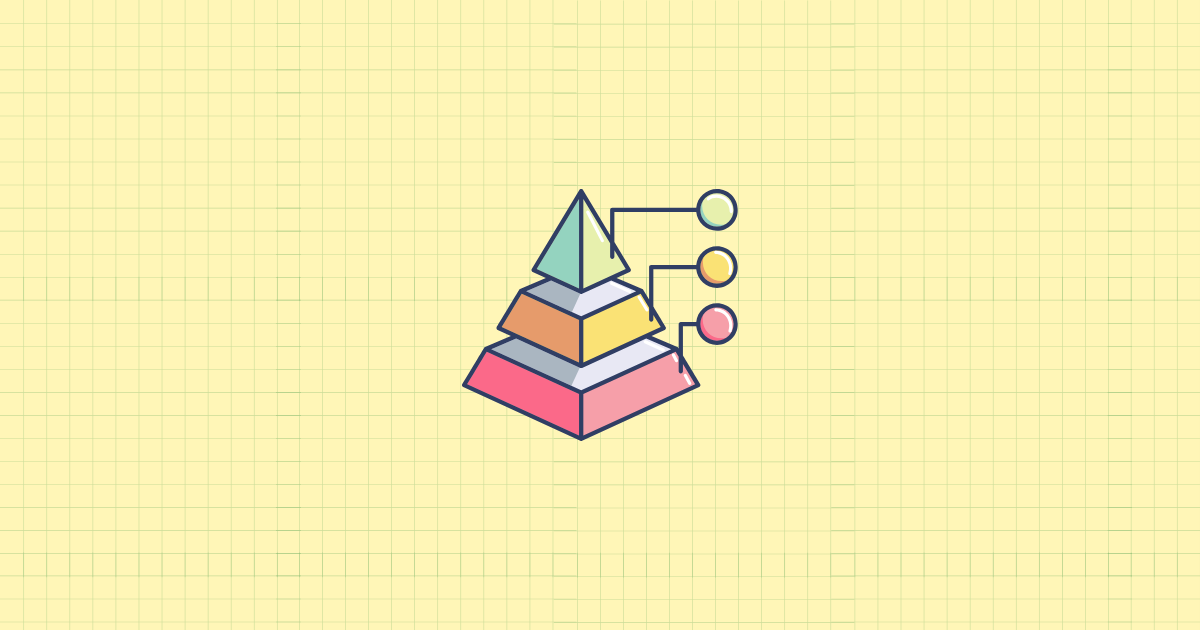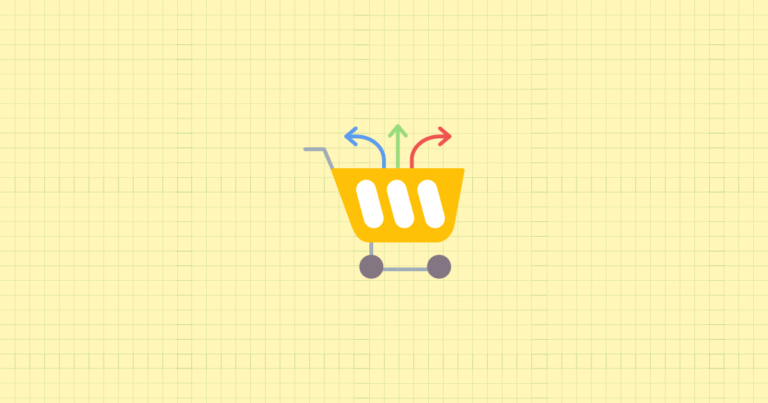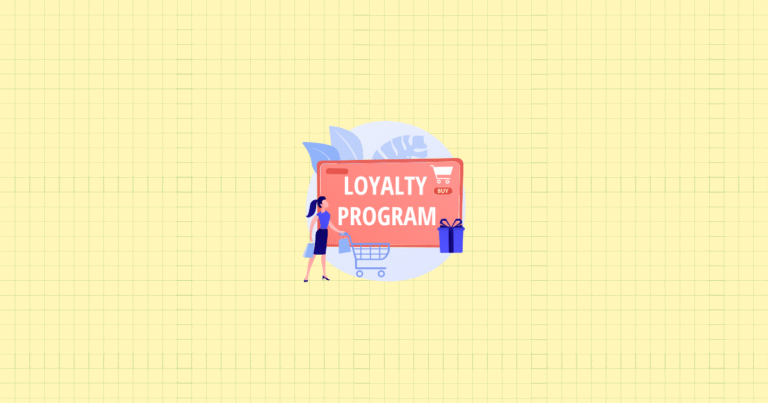Here’s a brutal truth about e-commerce that nobody talks about: Most Shopify store owners are leaving money on the table every single day. You’ve worked hard to drive traffic to your store, spent countless hours perfecting your product pages, and invested heavily in advertising. But when customers finally arrive with their credit cards ready, something goes wrong. They buy one item when they could have bought three. They spend $50 when they could have spent $150.
What if there was a way to naturally encourage customers to spend more without feeling pushy or manipulative? Enter tiered discount strategies – a psychological pricing approach that rewards customers for larger purchases while dramatically boosting your average order value.
In this comprehensive guide, we’ll explore how to implement tiered discounts that feel like genuine rewards rather than sales tactics. You’ll discover the psychology behind effective tier structures, learn multiple implementation methods (including native Shopify options), and uncover advanced strategies used by successful stores to increase their revenue by 30% or more. Let’s turn those single-item buyers into bulk purchasers who can’t resist climbing to the next savings tier.
Understanding Tiered Discount Fundamentals
Tiered discounts represent a fundamental shift in how you think about pricing. Instead of offering blanket discounts that erode your margins, you create structured price reductions that activate only when customers reach specific purchase thresholds. Think of it as a loyalty ladder built into every transaction.
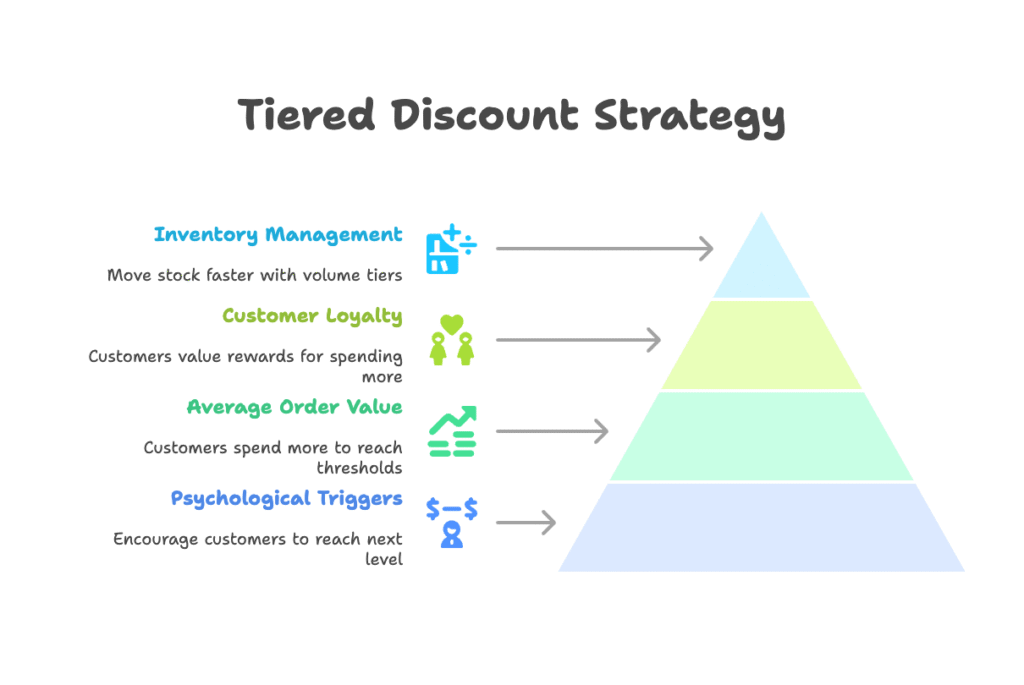
The core concept is elegantly simple: the more customers buy, the more they save. But here’s where it gets interesting – and where most stores get it wrong. Effective tiered discounts aren’t just about offering bigger discounts for bigger purchases. They’re about creating psychological triggers that make customers want to reach the next level.
Benefits for Shopify Store Owners
The advantages of well-designed tiered discounts extend far beyond simple revenue increases. First, you’ll see immediate improvements in average order value as customers naturally gravitate toward higher spending tiers. This happens because people hate leaving money on the table – if they’re only $20 away from 15% off their entire order, they’ll find that extra $20 to spend.
Customer loyalty gets a significant boost too. When shoppers feel they’re getting genuine value for spending more, they develop a positive association with your brand. They’re not just buying products; they’re unlocking rewards. This creates a stickiness factor that keeps them returning to your store instead of shopping with competitors.
For inventory management, tiered discounts can be a game-changer. Volume-based tiers help move stock faster, while spend-based tiers can push slow-moving items when customers need to reach the next threshold. The result? Better cash flow and fewer markdown sales down the line.
Tiered Pricing vs. Other Discount Models
Here’s where many store owners get confused – and it’s costing them sales. Tiered pricing differs significantly from volume pricing, though they’re often mistaken for the same thing. With volume pricing, you apply a fixed percentage or amount off based on total quantity. Buy 10 items, get 20% off. Simple, but limited.
Tiered pricing is more sophisticated. Price decreases happen at specific thresholds, with calculations applied per tier. For example: $10 per unit for 1-50 units, $8 per unit for 51-100 units, $6 per unit for 101+ units. The customer pays different prices for different portions of their order, creating natural breakpoints that encourage larger purchases.
This differs dramatically from standard discount codes, which offer static reductions. Tiered discounts are dynamic, responding to customer behavior in real-time. They influence decision-making at the moment of purchase, encouraging customers to add just one more item to unlock the next savings level.
Types of Tiered Discount Models for Shopify
Not all tiered discounts are created equal. The model you choose depends on your products, margins, and customer behavior. Let’s explore the most effective approaches, starting with the foundation that works for virtually every e-commerce business.
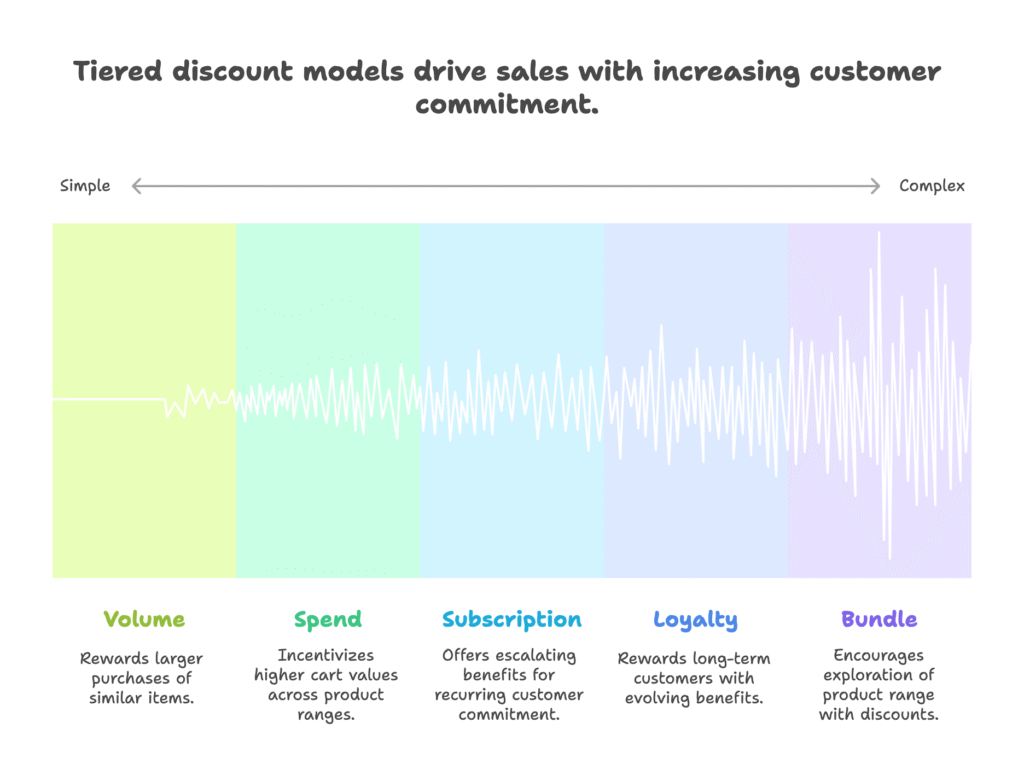
Volume-Based Tiered Discounts
Volume-based tiers reward customers for buying more quantities of the same or similar products. This model works exceptionally well for businesses with high inventory turnover or products that customers naturally buy in multiples – think office supplies, beauty products, or household items.
The structure is straightforward but requires careful planning. You set quantity thresholds where the per-unit price drops. A clothing retailer might offer: 1 t-shirt for $25, 2-3 t-shirts for $22 each, 4-5 t-shirts for $20 each, and 6+ t-shirts for $18 each. The customer sees immediate value in buying more, especially if they were already considering multiple items.
But here’s the critical consideration most stores miss: your quantity breaks must align with your profit margins. If you’re offering $18 per unit for 6+ items when your cost is $15, you’re operating on razor-thin margins. Smart retailers analyze their cost structure first, then work backward to determine sustainable tier pricing.
Visual display becomes crucial with volume-based tiers. Customers need to see the savings clearly on product pages, ideally with a visual calculator showing exactly how much they’ll save by adding more items. The best implementations show both the per-unit savings and total order savings, making the value proposition impossible to ignore.
Spend-Based Tiered Discounts
Spend-based tiers focus on cart value rather than quantity, making them perfect for stores with diverse product ranges or varying price points. The “Buy More, Save More” approach creates psychological anchors that guide purchasing decisions.
A typical structure might look like: Spend $50 and get 10% off, spend $100 and get 15% off, spend $150 and get 20% off. The beauty of this model lies in its simplicity and universal applicability. Whether customers buy one expensive item or several cheaper ones, the savings mechanism remains the same.
Setting strategic thresholds requires understanding your current average order value. If your AOV is $75, setting your first tier at $50 creates an easy entry point, while subsequent tiers at $100 and $150 provide natural progression goals. The sweet spot is creating “achievable jumps” – gaps between tiers that feel surmountable rather than overwhelming.
The most successful implementations display progress indicators throughout the shopping experience. Cart pages should show customers how close they are to the next tier, ideally with suggestions for products that would get them there. This isn’t just good user experience; it’s strategic revenue optimization.
Specialized Tiered Discount Models
Beyond the foundational approaches, several specialized models can transform customer relationships and dramatically increase lifetime value. These require more sophisticated implementation but offer correspondingly higher rewards.
Subscription-based tiered pricing works particularly well for businesses with recurring customers. Basic subscribers might get access to standard products, while premium tiers unlock exclusive items, early access, or enhanced services. The key is ensuring each tier provides genuine value that justifies the higher commitment level.
Loyalty-based tiered discounts create long-term customer relationships by rewarding cumulative behavior. Bronze, Silver, and Gold membership levels based on total lifetime spend or purchase frequency encourage customers to remain loyal to unlock better benefits. Unlike one-time discounts, these tiers evolve with the customer relationship.
Product bundle tiered pricing encourages customers to explore your full range. Buy one skincare product, get 5% off. Add a second from a different category, get 10% off. Add a third, get 15% off. This model works exceptionally well when you can create natural product groupings that enhance the customer’s experience while increasing your sales.
Native Implementation Methods in Shopify
You don’t need expensive apps to start implementing tiered discounts. Shopify’s native features provide several options for creating basic tier structures, though they come with limitations you need to understand upfront.
Using Automatic Discounts Feature
Shopify’s automatic discounts feature allows you to create multiple discounts with different minimum purchase requirements. The system applies the highest eligible discount automatically, creating a pseudo-tiered experience for customers.
Here’s how it works: Create three automatic discounts – 10% off orders over $50, 15% off orders over $100, and 20% off orders over $150. When a customer’s cart reaches $100, they automatically receive the 15% discount. Reach $150, and the 20% discount takes precedence.
The setup process is straightforward through your Shopify admin. Navigate to Discounts, create a new automatic discount, set your minimum purchase requirement, and configure the discount value. Repeat for each tier level you want to offer.
However, this approach has significant limitations. You can’t easily communicate all tier levels to customers during their shopping experience. The discounts apply automatically, but customers might not realize they’re close to unlocking a better deal. This passive approach misses the psychological benefits of showing progression toward savings goals.
Advanced Native Options for Shopify Plus
Shopify Plus merchants have access to Script Editor, which opens up sophisticated customization possibilities. Custom scripts can create complex tiered pricing that responds dynamically to cart contents, customer segments, or purchase history.
Script Editor allows you to automate discount application based on specific conditions. You might create a script that applies different percentage discounts based on product categories, customer tags, or even the time of purchase. The level of customization possible is impressive, but it comes with requirements.
You’ll need development resources or significant technical expertise to implement and maintain custom scripts. Every script requires thorough testing across different scenarios to ensure it behaves correctly. And unlike app-based solutions, custom scripts need ongoing maintenance as your store evolves.
For merchants with the resources to invest, Script Editor can create truly unique tiered discount experiences. But for most store owners, the complexity outweighs the benefits, especially when excellent third-party solutions exist.
Strategic Planning for Tiered Discount Campaigns
Creating effective tiered discounts isn’t about copying what successful stores are doing. It’s about understanding your specific business metrics and customer psychology, then designing tier structures that align with both. This strategic approach separates profitable implementations from expensive failures.
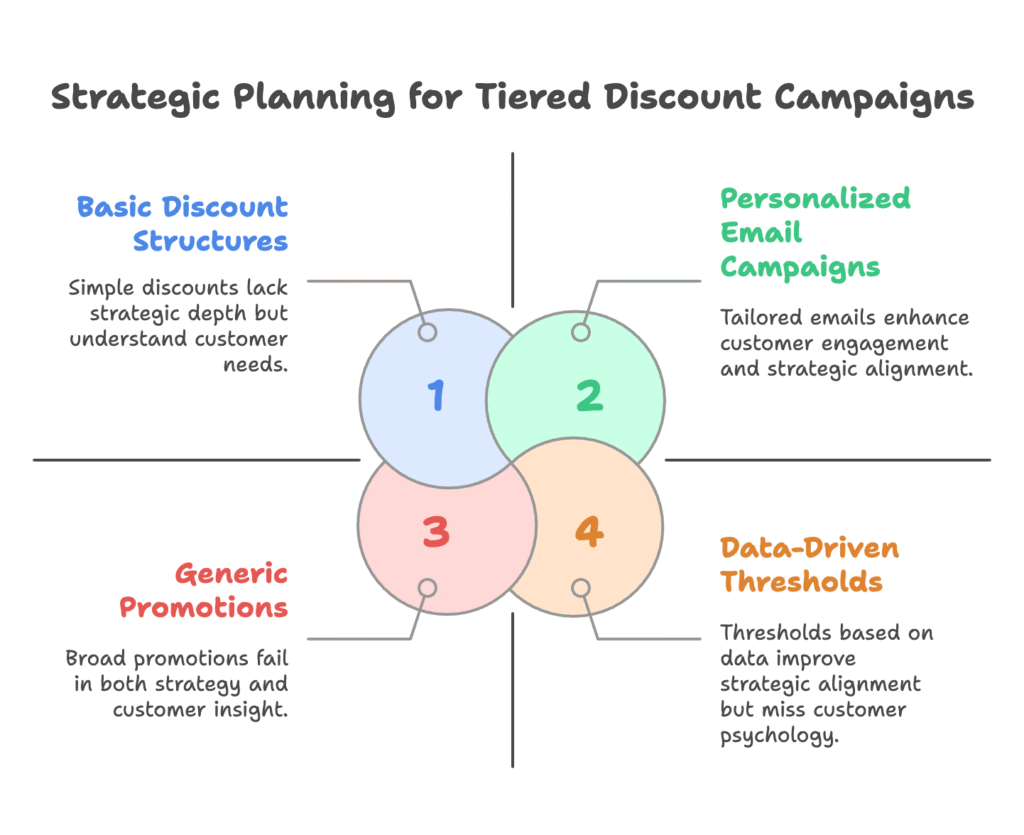
Setting Effective Discount Thresholds
Data should drive every threshold decision. Start by analyzing your current average order value across different time periods. Look for patterns – does AOV increase during certain seasons? Are there differences between new and returning customers? This baseline understanding informs everything that follows.
Your first tier should be set slightly below your current AOV to capture customers who would normally spend less, encouraging them to reach the threshold. Subsequent tiers should create meaningful jumps without feeling unrealistic. If your AOV is $75, consider tiers at $60, $100, and $140 rather than $50, $75, and $100.
Profit margin calculations are crucial at each tier level. Work backward from your desired profit margins to determine maximum discount percentages. If you need a 40% margin to maintain profitability, your highest tier discount shouldn’t exceed 30-35% to account for processing fees and operational costs.
Psychological pricing principles can enhance tier effectiveness. Setting thresholds at $99 instead of $100 feels more achievable to customers, even though the difference is minimal. This small adjustment can significantly impact tier adoption rates.
Designing Clear Customer Communication
The most brilliantly structured tier system fails without clear communication. Customers must understand the benefits available and how close they are to unlocking them. This requires strategic messaging throughout the shopping experience.
Product pages should display tier information prominently. Show customers what they’ll save on specific products at each tier level. A simple table or visual indicator can communicate complex savings structures instantly. Make the value proposition clear: “Buy 3 or more and save 20% on each.”
Cart page messaging becomes critical for conversion. Display progress bars showing proximity to the next tier. Suggest specific products that would help customers reach the next level. Use language that creates urgency without pressure: “Add $25 more to unlock 15% off your entire order.”
Color-coding and visual design elements help customers process tier information quickly. Use consistent colors for each tier level across your site. Create visual hierarchies that make the best deals obvious while maintaining a professional appearance.
Timing and Campaign Integration
Tiered discounts work best when integrated into your broader marketing strategy. They shouldn’t exist in isolation but rather complement your seasonal campaigns, email marketing, and promotional calendar.
Seasonal considerations can dramatically impact tier effectiveness. During high-traffic periods like Black Friday, you might lower thresholds or increase discount percentages. During slower periods, maintain standard tiers but enhance communication about the savings available.
Email marketing campaigns should prominently feature tier benefits. Segment your list based on purchase history to send personalized tier progression messages. A customer who typically spends $80 might receive targeted emails about reaching the $100 tier for additional savings.
Social media promotion strategies should showcase tier benefits creatively. Instead of simply announcing discounts, create content that demonstrates the value customers receive. Show realistic cart examples highlighting the savings at each tier level.
Advanced Implementation Strategies
Once you’ve mastered basic tier structures, advanced strategies can dramatically enhance their effectiveness. These approaches require more sophisticated thinking and implementation but offer proportionally higher returns.
Third-Party App Solutions
While native Shopify features provide basic tier functionality, dedicated apps unlock advanced capabilities that can transform your discount strategy. The right app choice depends on your specific needs and budget constraints.
When evaluating apps, prioritize feature alignment with your goals. Do you need automatic tier progression messaging? Advanced analytics? Integration with email marketing platforms? Create a requirements list before exploring options to avoid feature bloat.
Popular solutions like Discountly offer comprehensive tiered pricing with extensive customization options. VolumeBoost specializes in wholesale and loyalty rewards, making it ideal for B2B applications. Each app has strengths and limitations, so trial periods become essential for proper evaluation.
Consider implementation complexity versus benefit. Some apps require significant setup time and ongoing management. Others work immediately but offer limited customization. Balance your technical resources against your revenue goals to make the best choice.
Optimizing Multi-Channel Experience
Tiered discounts shouldn’t be confined to your website. The most successful implementations extend tier benefits across all customer touchpoints, creating a cohesive experience that reinforces the value proposition.
Email marketing integration allows you to send tier progression notifications as customers approach new levels. Abandoned cart emails can highlight tier benefits: “You’re only $25 away from 15% off your entire order.” This personalized approach significantly improves email performance.
Social media campaigns can creatively showcase tier benefits. Create content that demonstrates real savings examples. Partner with influencers to showcase tier benefits authentically. Use platform-specific features like Instagram Shopping to highlight tier pricing directly in posts.
The key is maintaining message consistency. Whether customers discover your tiers through email, social media, or direct website visits, the communication should be clear and aligned. Mixed messages confuse customers and reduce tier adoption rates.
A/B Testing and Optimization
Continuous optimization separates good tier strategies from great ones. Systematic testing reveals what works for your specific audience and products, moving beyond assumptions to data-driven decisions.
Test different threshold amounts to find optimal breakpoints. Try varying the gaps between tiers. Experiment with discount percentages versus fixed dollar amounts. Each variable can significantly impact customer behavior and business profitability.
Messaging tests can be equally revealing. Some customers respond better to percentage savings (“Save 20%”), while others prefer dollar amounts (“Save $30”). Test different progress indicators, urgency language, and visual presentations to optimize conversion rates.
Key performance indicators should guide your testing efforts. Monitor conversion rates by tier level, changes in average order value, customer acquisition costs, and long-term retention metrics. The goal isn’t just increased sales but profitable, sustainable growth.
Case Studies and Implementation Examples
Real-world examples provide valuable insights into what works and what doesn’t. These case studies illustrate how different businesses successfully implemented tiered discounts and the lessons learned along the way.
Successful Tiered Discount Implementations
A mid-sized apparel retailer implemented quantity-based tiers for their basic t-shirt line. Initially offering 1 shirt for $25, 3 for $22 each, and 5 for $20 each, they saw modest results. The breakthrough came when they adjusted the structure to 1 for $25, 2 for $23 each, 4 for $21 each, and 6 for $19 each.
The smaller initial jump (from 1 to 2 items) dramatically increased tier adoption. Customers felt the first discount was easily achievable, then naturally progressed to higher tiers. Average order value increased 35%, while customer satisfaction remained high because the savings felt earned rather than manipulative.
A beauty brand’s spend-based implementation focused on cart value tiers: $75 for 10% off, $125 for 15% off, and $175 for 20% off. They enhanced the basic structure with strategic product recommendations. When customers approached a tier threshold, targeted suggestions appeared for items that would unlock the next level.
This approach generated a 42% increase in average order value within six months. More importantly, customer lifetime value increased as shoppers discovered new products through tier-driven recommendations. The strategy evolved from simple discounting to sophisticated product discovery.
Common Pitfalls and Solutions
Not every tiered discount implementation succeeds. Understanding common failures helps avoid expensive mistakes and ensures your strategy delivers intended results from the start.
Discount cannibalization represents a significant risk. When you offer tier discounts to customers who would have paid full price anyway, you’re essentially giving away profit. The solution involves careful customer segmentation and strategic tier design that appeals primarily to price-sensitive buyers.
One effective approach restricts tier discounts to first-time customers or those who haven’t purchased in a specific timeframe. This protects your premium buyers while encouraging hesitant customers to make larger purchases. Email list segmentation can help deliver tier promotions to appropriate customer groups.
Technical implementation challenges often arise during setup. Common errors include incorrect threshold calculations, conflicting discount codes, and poor mobile display. Establish testing protocols that check tier functionality across different devices, cart sizes, and customer scenarios before launching campaigns.
Customer service preparation is frequently overlooked but essential. Train your support team to understand tier structures and troubleshoot common issues. Create clear explanations of how tiers work that support agents can share with confused customers. Consider FAQ sections addressing tier-related questions proactively.
Measuring Success and Future Trends
Implementing tiered discounts is just the beginning. Long-term success requires ongoing measurement, optimization, and adaptation to evolving customer expectations and technological capabilities.
Analytics and Performance Tracking
Effective measurement begins with establishing baseline metrics before implementing tiered discounts. Track your current average order value, conversion rates, customer acquisition costs, and profit margins. These benchmarks allow you to quantify the impact of your tier strategy accurately.
Tier-specific metrics provide deeper insights. Monitor conversion rates at each tier level to identify which thresholds work best. Track how customers migrate between tiers over time. Analyze profit margins by tier to ensure higher discounts don’t erode profitability excessively.
Shopify’s native analytics provide basic tier tracking when you tag customers or orders based on tier usage. However, dedicated analytics tools or apps offer more sophisticated insights. Look for solutions that provide cohort analysis, customer lifetime value tracking, and tier progression visualization.
Long-term analysis reveals tier strategy effectiveness beyond immediate sales increases. Monitor customer retention rates for tier users versus non-tier customers. Track how tier adoption influences subsequent purchase behavior. These insights inform future tier structure adjustments and business strategy decisions.
Emerging Trends in Tiered Discount Strategies
The future of tiered discounts lies in personalization and artificial intelligence. Advanced algorithms can analyze individual customer behavior to create customized tier structures that optimize for each shopper’s preferences and purchasing patterns.
AI-powered personalization is already emerging in sophisticated e-commerce platforms. Instead of offering the same tier structure to all customers, systems can adjust thresholds and discount percentages based on individual purchase history, browsing behavior, and predicted lifetime value.
Dynamic pricing algorithms represent the next evolution in tier strategies. These systems continuously adjust tier structures based on real-time data including inventory levels, demand patterns, and competitive pricing. The result is optimized tier structures that respond to market conditions automatically.
Integration with broader loyalty ecosystems is becoming increasingly important. Modern customers expect cohesive experiences across all touchpoints. Future tier strategies will seamlessly integrate with points programs, subscription services, and community-based rewards to create comprehensive loyalty ecosystems.
Subscription model integration offers particular promise for businesses with recurring customers. Tiered subscription pricing based on volume commitments or feature access creates predictable revenue while providing customers with clear value progression paths.
References
- The Shop Strategy. (2025, March 31). Shopify Discount Strategy Fundamentals. Retrieved from https://theshopstrategy.com/store-growth-optimization/promotions-discount-strategies/shopify-discount-strategy-fundamentals/
- Praella. (2024, November 29). Mastering Shopify Tiered Discounts: Strategies for Boosting Sales and Customer Engagement. Retrieved from https://praella.com/blogs/shopify-insights/mastering-shopify-tiered-discounts-strategies-for-boosting-sales-and-customer-engagement
- Shopify. (2025). Official Shopify Documentation – Discounts. Retrieved from https://help.shopify.com/en/manual/discounts
Ready to transform your single-item buyers into bulk purchasers with perfectly optimized tiered discounts? Growth Suite is a Shopify app that intelligently tracks visitor behavior and presents personalized, time-limited offers to increase your conversion rates and average order value. Unlike generic discount strategies, Growth Suite creates genuine urgency that encourages larger purchases without devaluing your brand. Install it with a single click and start seeing results immediately – no complex setup required, just smart discount optimization that works.
